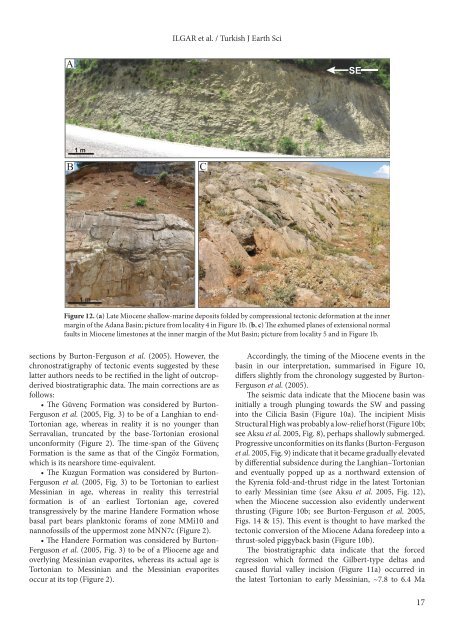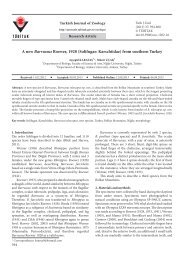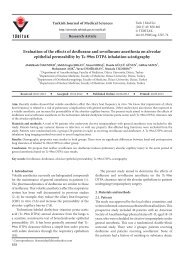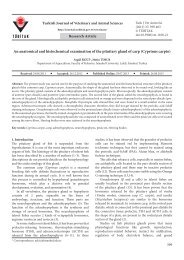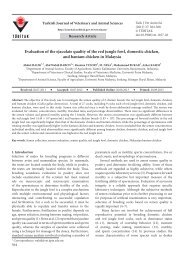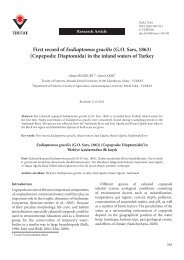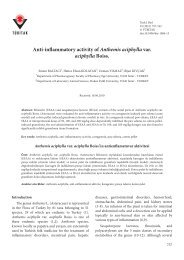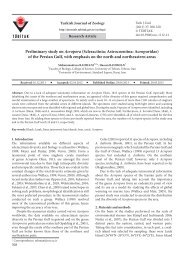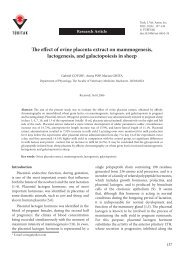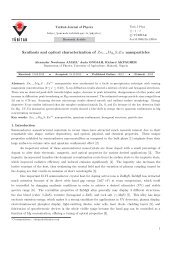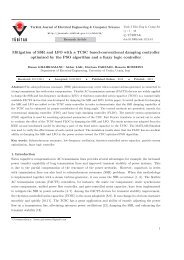Messinian forced regressions in the Adana Basin: a near ... - Tübitak
Messinian forced regressions in the Adana Basin: a near ... - Tübitak
Messinian forced regressions in the Adana Basin: a near ... - Tübitak
You also want an ePaper? Increase the reach of your titles
YUMPU automatically turns print PDFs into web optimized ePapers that Google loves.
A<br />
B<br />
1 m<br />
sections by Burton-Ferguson et al. (2005). However, <strong>the</strong><br />
chronostratigraphy of tectonic events suggested by <strong>the</strong>se<br />
latter authors needs to be rectified <strong>in</strong> <strong>the</strong> light of outcropderived<br />
biostratigraphic data. The ma<strong>in</strong> corrections are as<br />
follows:<br />
• The Güvenç Formation was considered by Burton-<br />
Ferguson et al. (2005, Fig. 3) to be of a Langhian to end-<br />
Tortonian age, whereas <strong>in</strong> reality it is no younger than<br />
Serravalian, truncated by <strong>the</strong> base-Tortonian erosional<br />
unconformity (Figure 2). The time-span of <strong>the</strong> Güvenç<br />
Formation is <strong>the</strong> same as that of <strong>the</strong> C<strong>in</strong>göz Formation,<br />
which is its <strong>near</strong>shore time-equivalent.<br />
• The Kuzgun Formation was considered by Burton-<br />
Ferguson et al. (2005, Fig. 3) to be Tortonian to earliest<br />
<strong>Mess<strong>in</strong>ian</strong> <strong>in</strong> age, whereas <strong>in</strong> reality this terrestrial<br />
formation is of an earliest Tortonian age, covered<br />
transgressively by <strong>the</strong> mar<strong>in</strong>e Handere Formation whose<br />
basal part bears planktonic forams of zone MMi10 and<br />
nannofossils of <strong>the</strong> uppermost zone MNN7c (Figure 2).<br />
• The Handere Formation was considered by Burton-<br />
Ferguson et al. (2005, Fig. 3) to be of a Pliocene age and<br />
overly<strong>in</strong>g <strong>Mess<strong>in</strong>ian</strong> evaporites, whereas its actual age is<br />
Tortonian to <strong>Mess<strong>in</strong>ian</strong> and <strong>the</strong> <strong>Mess<strong>in</strong>ian</strong> evaporites<br />
occur at its top (Figure 2).<br />
ILGAR et al. / Turkish J Earth Sci<br />
C<br />
1 m 1 m<br />
Figure 12. (a) Late Miocene shallow-mar<strong>in</strong>e deposits folded by compressional tectonic deformation at <strong>the</strong> <strong>in</strong>ner<br />
marg<strong>in</strong> of <strong>the</strong> <strong>Adana</strong> Bas<strong>in</strong>; picture from locality 4 <strong>in</strong> Figure 1b. (b, c) The exhumed planes of extensional normal<br />
faults <strong>in</strong> Miocene limestones at <strong>the</strong> <strong>in</strong>ner marg<strong>in</strong> of <strong>the</strong> Mut Bas<strong>in</strong>; picture from locality 5 and <strong>in</strong> Figure 1b.<br />
SE<br />
Accord<strong>in</strong>gly, <strong>the</strong> tim<strong>in</strong>g of <strong>the</strong> Miocene events <strong>in</strong> <strong>the</strong><br />
bas<strong>in</strong> <strong>in</strong> our <strong>in</strong>terpretation, summarised <strong>in</strong> Figure 10,<br />
differs slightly from <strong>the</strong> chronology suggested by Burton-<br />
Ferguson et al. (2005).<br />
The seismic data <strong>in</strong>dicate that <strong>the</strong> Miocene bas<strong>in</strong> was<br />
<strong>in</strong>itially a trough plung<strong>in</strong>g towards <strong>the</strong> SW and pass<strong>in</strong>g<br />
<strong>in</strong>to <strong>the</strong> Cilicia Bas<strong>in</strong> (Figure 10a). The <strong>in</strong>cipient Misis<br />
Structural High was probably a low-relief horst (Figure 10b;<br />
see Aksu et al. 2005, Fig. 8), perhaps shallowly submerged.<br />
Progressive unconformities on its flanks (Burton-Ferguson<br />
et al. 2005, Fig. 9) <strong>in</strong>dicate that it became gradually elevated<br />
by differential subsidence dur<strong>in</strong>g <strong>the</strong> Langhian–Tortonian<br />
and eventually popped up as a northward extension of<br />
<strong>the</strong> Kyrenia fold-and-thrust ridge <strong>in</strong> <strong>the</strong> latest Tortonian<br />
to early <strong>Mess<strong>in</strong>ian</strong> time (see Aksu et al. 2005, Fig. 12),<br />
when <strong>the</strong> Miocene succession also evidently underwent<br />
thrust<strong>in</strong>g (Figure 10b; see Burton-Ferguson et al. 2005,<br />
Figs. 14 & 15). This event is thought to have marked <strong>the</strong><br />
tectonic conversion of <strong>the</strong> Miocene <strong>Adana</strong> foredeep <strong>in</strong>to a<br />
thrust-soled piggyback bas<strong>in</strong> (Figure 10b).<br />
The biostratigraphic data <strong>in</strong>dicate that <strong>the</strong> <strong>forced</strong><br />
regression which formed <strong>the</strong> Gilbert-type deltas and<br />
caused fluvial valley <strong>in</strong>cision (Figure 11a) occurred <strong>in</strong><br />
<strong>the</strong> latest Tortonian to early <strong>Mess<strong>in</strong>ian</strong>, ~7.8 to 6.4 Ma<br />
17


